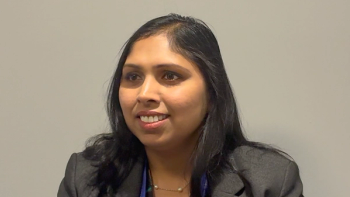
- Oncology Vol 28 No 4_Suppl_1
- Volume 28
- Issue 4_Suppl_1
(S027) Patterns of Failure for Rhabdomyosarcoma of the Perineal and Perianal Region
Purpose: Rhabdomyosarcoma of the perineal and perianal region (PRMS) has poor outcomes. We analyzed prognostic factors and patterns of failure, with an emphasis on radiotherapy for locoregional control.
Dana L. Casey, Leonard H. Wexler, MD, Michael P. LaQuaglia, MD, Paul A. Meyers, MD, Suzanne L. Wolden, MD, FACR; Memorial Sloan-Kettering Cancer Center
Purpose: Rhabdomyosarcoma of the perineal and perianal region (PRMS) has poor outcomes. We analyzed prognostic factors and patterns of failure, with an emphasis on radiotherapy for locoregional control.
Materials and Methods: Detailed records of all 15 patients treated for PRMS at Memorial Sloan-Kettering between 1998 and 2012 were reviewed. The Kaplan-Meier method was used to assess event-free survival (EFS) and overall survival (OS), and a competing-risks analysis was used to assess the cumulative incidence of local, regional, and distant failures.
Results: Median age was 15.1 years (range: 0.9–31.9 yr). High-risk features were identified: 73% of the patients had group III disease and 20% had group IV; 67% of tumors were alveolar; 87% of tumors were ≥ 5 cm; and 67% of patients had involved lymph nodes (N1). Of those aged ≥ 10 years at diagnosis, 89% had alveolar histology, 100% had tumors ≥ 5 cm, and 78% presented with N1 disease. The rates of local, regional, and distant failure at 5 years were 16%, 36%, and 35%, respectively. Although four of the five patients with regional failure received nodal irradiation, only one of the nodal failures occurred in the radiotherapy field. The 5-year EFS was 42%, and OS was 56%. Age ≥ 10 years was associated with poor outcomes: EFS was 15% in patients aged ≥ 10 years compared with 67% in those aged < 10 years (P = .04); the OS was 22% in patients aged ≥ 10 years compared with 100% in those aged < 10 years (P = .05).
Conclusions: Patients with PRMS, especially those aged ≥ 10 years, present with poor prognostic features and continue to have poor outcomes. Given the high incidence of regional node recurrence, we recommend prophylactic ilioinguinal lymph node irradiation for all patients aged ≥ 10 years. For children aged < 10 years, surgical evaluation of the ilioinguinal lymph nodes to determine the role for nodal irradiation is appropriate.
Proceedings of the 96th Annual Meeting of the American Radium Society -
Articles in this issue
Newsletter
Stay up to date on recent advances in the multidisciplinary approach to cancer.





















































































